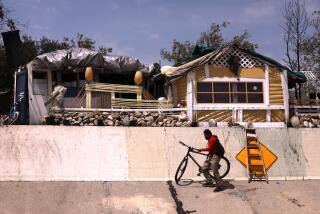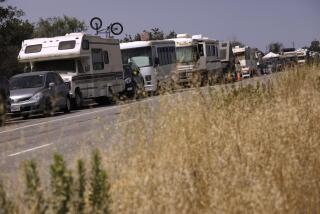Armory Gives Warmth to the Homeless : Services: National Guard shelter offers refuge from the chill as well as danger of the streets.
- Share via
ENCINO — With daytime temperatures in the mid-70s so far this winter, a cold-weather shelter for the homeless might seem unwarranted.
But for the people who would otherwise spend their nights on the streets of the San Fernando Valley--braving temperatures that can drop 20 to 30 degrees despite balmy afternoons--the temporary shelter at the National Guard Armory in Encino is a welcome alternative.
“It’s safer here. You never know (what will happen) when you are on the streets,” said Toni Knapp, 19, who has spent every night at the shelter since it opened on Dec. 13.
Against the back wall of the armory, Knapp has set up a makeshift bedroom for herself and her husband Peter, 36--two cots pushed together, two blankets, a small television and some fishing rods they found while looking in dumpsters.
It will be their home until the end of February, when the shelter closes for the season.
Every winter, for the past five years, the Los Angeles Homeless Services Authority has overseen emergency cold-weather shelters throughout the county with beds for 2,000 people.
The shelters are open every day between Dec. 13 and Feb. 28. During November and after Feb. 28, the shelters are open if there is a 50% or greater chance of rain or if the temperature drops below 40 degrees.
The shelter at the Encino armory is run by the L.A. Family Housing Corp. in North Hollywood, which also operates the Valley’s only year-round homeless shelter. Joe Zuniga, the program’s coordinator, said there is a definite need for additional beds in winter.
“Every year, it starts out slow but it steadily increases,” Zuniga said. “We’ll fill up all 155 spots.”
Currently, there are just over 100 people at the armory every night. Families who come seeking a place to stay are given a meal and a voucher to stay at a motel for up to three days.
Family Housing has also arranged a shuttle that stops in five Valley locations--from Canoga Park to Hansen Dam--to pick up potential clients. Robert Archibeque, who works the 5:30 p.m. to midnight shift at the armory, said the shelter gets about half its users from the shuttle service.
The rest come on their own, waiting until the shelter opens each evening.
“We open the doors at 5:30 p.m., sign them in, give them an identification card, have them sign up for a shower, give them a bunk and a blanket and they eat, watch TV or go to sleep,” Archibeque said.
For the most part, the same folks show up nightly, shelter workers said. Many are only recently homeless.
Vartan Sarkissian, 38, grew up in Los Angeles, has family in the Valley and had been living with his parents. He said he has been forced to periodically live on the streets or in shelters for the past year, ever since his mother’s death threw the family into turmoil.
Curtis, 43, is a recent parolee who has yet to re-establish himself in society. Curtis, who declined to give his full name, said he completed a four-year prison term for robbery.
He was released to the Valley, where he was living with his girlfriend before his arrest, and is required to report to a parole officer here, he said. But his girlfriend has since left the area, said Curtis, whose roots are in his hometown of Richmond in Northern California.
“So, I’m homeless,” he shrugged.
Zuniga said most shelter clients defy stereotypes of the homeless as chronically helpless people.
“All of these people are very aware,” Zuniga said. “They are mostly down on their luck--lost their job, got divorced. . . . Maybe 20% to 30% of them are long-term homeless.”
More to Read
Sign up for Essential California
The most important California stories and recommendations in your inbox every morning.
You may occasionally receive promotional content from the Los Angeles Times.










